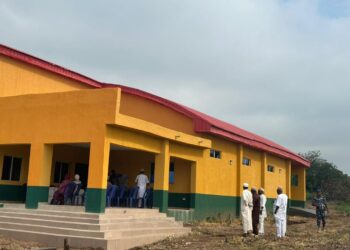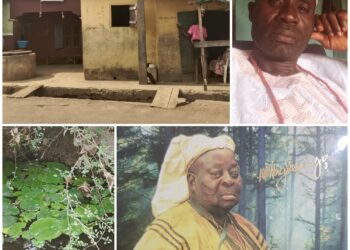Sayo Àlàgbé
Since the creation of the universe by Elèdùmarè, the Supreme Creator, He has crafted both humans and animals, along with the wonders of the world. Among these are the vast oceans, rivers, streams, lakes, and brooks, as well as majestic hills, valleys, and mountains. Alongside these natural marvels, Elèdùmarè also created mysteries intrinsically tied to rivers, trees, rocks, valleys, and anthills. Complementing these are invisible beings and spirits such as river goddesses, elves, and fiery entities, which work in harmony with these sacred sites.

Intrigued by these mysteries, ScoopChase embarked on an excursion to one of the most historic towns in Yorubaland—Jàbàtá—to explore its heritage and interview its traditional ruler, His Royal Majesty, Oba Mustapha Àlàdé Mófóláseré Àjàlá, JP, SCN, Fàdípè 111, the Onijàbàtá of Jàbàtáland.
According to Oba Jàbàtá, history records that Jàbàtá, located in the present-day Surulere Local Government Area of Oyo State, has played a significant role in preserving Yoruba tradition, customs, and heritage. Beyond its cultural significance, Jàbàtá has also contributed to the defense and territorial integrity of the old Oyo Empire. In fact, the history of Yorubaland is incomplete without mentioning Jàbàtá.
Jàbàtá’s Connection to Oranmiyan and the Founding of Oyo
Historical accounts reveal that when Oranmiyan and his siblings left Ilé-Ifè on an exploratory journey for new settlements, he appointed Jàbàtá—a powerful Ifá priest with clairvoyant abilities—as his spiritual guide. Upon reaching a place known as Òdò-Oya (now the River Niger), the river overflowed its banks, leaving Oranmiyan and his followers uncertain about crossing. Jàbàtá consulted Ifá, and the Oracle warned against crossing, predicting disaster if they did.
At that moment, a cobra appeared on the Ifá tray, signaling Oranmiyan to follow its lead. The snake guided them until it stopped at a place called Òyó’rò, where they settled temporarily. Soon after, Ifá instructed them to leave, and the snake led them to Òyó-Ilé, then Òyó Ìgbòho, and finally to the present Òyó – called Òyó Àtìbà, where they permanently established the Oyo Kingdom.
During the Fulani invasion of the Oyo Empire, Alaafin Oranmiyan, relying on Jàbàtá’s mystical prowess, ordered him to relocate to Òté, an outpost, to prevent the Jihadists from advancing into Yorubaland. While many of Jàbàtá’s followers settled in Jàbàtá, others remained with Alaafin Oranmiyan at Òyó Àtìbà, where they established their own settlement.
Jàbàtá’s Military Legacy and the Ààre Ona Kakanfò Institution
Jàbàtá’s contribution to Yoruba military history is profound. The town produced two notable Ààre Ona Kakanfòs (Yoruba war generals): Adéta and Ókù. These warriors played critical roles in the defense and expansion of the Oyo Empire. Additionally, King Fágbòhun of Jàbàtá served as the Òsì Kakanfò (Commander of the Left Flank) during the reign of Àfònjá of Ìlorin.
Oba Mustapha Alade traced the origin of the Ààre Ona Kakanfò institution to Alaafin Àjàgbó, who, after the fall of Old Oyo, intensified military investments to safeguard the empire. The first Ààre Ona Kakanfò, Kòkòrògàngan from Ìwòyé, was appointed by Alaafin Àjàgbó. Since then, fifteen warriors have held the title, including:
1. Kòkòrògàngan (Ìwòyé)
2. Oyátópé (Ìwòyé)
3. Oyáàbi (Àjàsé)
4. Adéta (Jàbàtá)
5. Ókù (Jàbàtá)
6. Àfònjá (Ìlorin)
7. Tóyèje (Ogbomoso)
8. Edun (Gbógun)
9. Amépo (Abemo)
10. Kúrúnmí (Ìjàyé)
11. Òjó Aburúmákú (Ogbomoso)
12. Láátòsá (Ibadan)
13. Samuel Ladoke Akíntólá (Ogbomoso)
14. M.K.O. Abiola (Abeokuta)
15. Gani Adams (Arigidi-Àkókó)
Oba Mustapha Alade emphasized that Tóyèje of Ogbomoso served as the Òtún Ààre Kakanfò (Commander of the Right Flank), while Fágbòhun of Jàbàtá was the Òsì Kakanfò. He highlighted how Fágbòhun repeatedly warned Ààre Àfònjá against recruiting Fulani warriors, a mistake that ultimately led to the downfall of Àfònjá and had severe repercussions for the Yoruba nation.
The Spread of Jàbàtá Across Yorubaland
Due to the Fulani conquest of Ilorin, Jàbàtá descendants migrated to different parts of the Southwest in defense of the old Oyo Empire, leading to the establishment of several Jàbàtá settlements, including:
1. Jàbàtá-Orile – Near Orile Igbon, Surulere LGA, Oyo State
2. Jàbàtá Òyó – Oyo Municipality, Oyo Àtìbà, Oyo State
3. Jàbàtá (Yewa) – Near Ìwòyé, Ìmèko Afon, Ogun State
4. Jàbàtá (Remo) – Near Ìparà, Remo North, Ogun State
5. Jàbàtá Ilorin – Ilorin Municipality, Kwara State
Tourism and Mystical Wonders of Jàbàtá
Oba Mustapha Alade highlighted Jàbàtá’s rich tourism potential, including two significant sites:
Igbo Òòsa: A sacred forest where Jàbàtá’s ancestors are believed to have entered the ground. Within this forest lies a mysterious pot that remains full of water year-round, regardless of the season. Every year, Jàbàtá descendants from around the world return home to pay homage to their ancestors at this sacred site.
Odo Babalóòsà: A river that never dries up, known for its spiritual significance. People seeking children, prosperity, or community peace visit this river for prayers and blessings.
Oba Mustapha Alade urged the Oyo State Government to invest in tourism, emphasizing that properly harnessing these historical sites could generate substantial revenue and enhance the economic prosperity of both the town and the state.
Jàbàtá’s historical, military, and mystical significance cements its place as an indispensable part of Yoruba history. From serving as the spiritual guide of Oranmiyan to producing powerful warlords and preserving sacred traditions, the town remains a beacon of Yoruba heritage.
You can get every of our news as soon as they drop on WhatsApp ...To get all news updates, Join our WhatsApp Group (Click Here)







